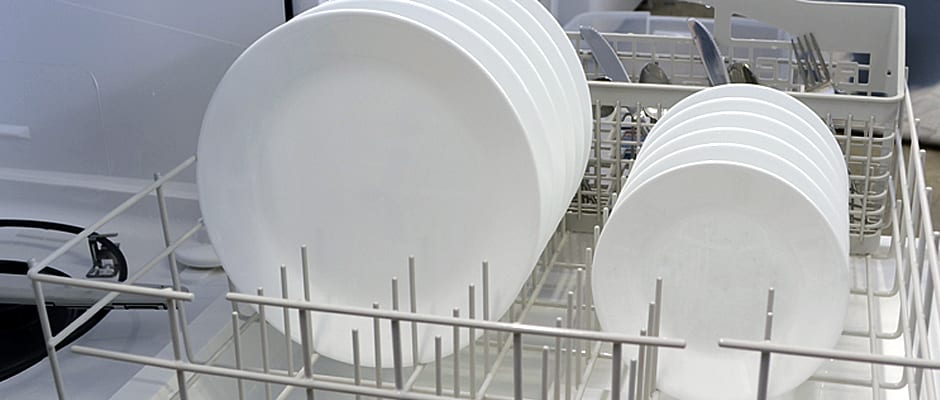Pros
Cons
Introduction
Design & Usability
Nothing fancy about this at all.
The ADB1100AWB does nothing to hide its low-cost roots, and almost seems to revel in it. Perhaps it just doesn't care about third racks and steam cycles. The outside is plain black, with a front-facing plastic control panel that very clearly advertises its lack of versatility: there are only three wash cycles and two additional wash options. For those who want a touch of refinement, the ADB1100AWB does have a stainless steel version that costs $50 more, but even that model has a black plastic control panel that stands out from the rest of its steel door.
The interior also looks unashamedly entry-level. The tub itself is bright, white plastic, which does a poor job muffling sound. Rest assured, when the ADB1100AWB is running, you will know. Neither the top nor bottom rack have any adjustable tines, and the cutlery basket lacks slots for keeping your silverware separated. That's way too fancy for the ADB1100AWB.
Of course, that leads to a ton of usability issues. We could barely fit ten place settings and a serving setting into the ADB1100AWB, having trouble finding a good spot to fit all the large serving dishes while still leaving room for the smaller plates and bowls. Another issue we see is the lack of a Control Lock feature. This is especially problematic since this is a machine with front-facing controls and a Cancel button, and the clumsier folks in your family just might turn the machine off by accident.
{{photo_gallery "Design Gallery"}}
Features
{{section_header}}{{ section.name }}{{/section_header}}
Just enough to cover ordinary dishwashing needs.
The ADB1100AWB’s sparse features can be seen just from looking at its control panel. It has three wash cycles to choose from: Normal, Heavy, and 1-Hour. Interestingly, those options are selected on a pushbutton control panel instead of an old-fashioned dial. As added options, there’s Hi Temp for raising wash temperatures against tougher stains and Heat Dry to dry your dishes at the end of a cycle. If your old dishwasher is 10 years old, this one will still likely be an upgrade.
Performance
A far better cleaning performance than its price tag would suggest.
In spite of the low upfront cost and cheap appearance, the ADB1100AWB actually delivers when it comes to performance. We put each of its three cycles through a battery of tests and sometimes got results that were similar to more expensive dishwashers. The Normal cycle, designed for everyday use, gave good scores with typical milk, meat, and egg stains. It performed a bit worse with baked-on oatmeal and spinach. Keep in mind that these are far heavier stains than we would expect from a normal consumer, and no dishwasher we’ve tested has ever been able to perfectly remove them on a Normal cycle. Still, you're going to have to do some scraping if you buy this machine.
The big issue is that it took two hours and 19 minutes to do a decent job cleaning dishes. If a wash takes that long, we expect it to have far fewer flaws.
The Heavy cycle, which is designed for tougher stains, did a better job than the Normal on every stain, but still took upwards of three hours. Even when we threw in burnt sugar, burnt cheese, and baked-on lasagna, the ADB1100AWB’s Heavy cycle posted very high scores. We did notice some issues with redeposit, though. This is when dirt from one dish is sprayed to another during the cycle, essentially making a cleaned dish dirty again. While this problem was virtually non-existent on the Normal cycle, the Heavy cycle sprayed bits of spinach to the glasses that were used for milk stains. That's a sign of a filtration system that couldn't handle the mess we gave it.
The 1-Hour cycle had the worst cleaning performance, but it at least finished in exactly 60 minutes. It even handled the meat and egg stains like a champ, but we wouldn't use it on anything but the most lightly soiled dishes.
Conclusion
{{section_header}}{{ section.name }}{{/section_header}}
Its inexpensive enough to still be a good value
It's only an indicator of how good the competition is that the ADB1100AWB scored so low in our tests. It didn't have any fundamental flaws, but it's quite unrefined. Even if you don’t need a third rack or an Eco wash cycle, little things like digital timers, folding tines, enhanced filtration, and better sound insulation help make the dishwashing experience a lot more pleasant. You won't get those with the ADB1100AWB. If you're willing to wait awhile for a cycle to complete, though, you will get cleaning results on par with machines that cost a bit more than $299. If a low price and clean dishes are your only concerns, you could spend a lot more money on a lot worse dishwasher.
Introduction
{{section_header}}{{ section.name }}{{/section_header}}
If we were to judge the Amana ADB1100AWB on just washing performance and efficiency, it would’ve scored higher. In fact, they are the only good things we can really say about this dishwasher, as it is sorely lacking in features and customization. But no matter how you look at it, $299 is a great price for the level of performance that this machine gives.
Performance
{{section_header}}{{ section.name }}{{/section_header}}
Good enough to handle most messes.
We started our tests by running the ADB1100AWB’s two hour, 19 minute Normal cycle with food stains. When it came to milk, egg, and meat stains, this dishwasher was nearly perfect, leaving very little dirt behind. For the tougher oatmeal stains, the Normal cycle could only manage to remove about 90 percent: not bad, but not great. It only removed about 50% of the spinach stains, but at least none of it got sprayed onto the other dishes. As a result, we were generally happy with how the Normal cycle performed.
The three hour Heavy cycle was just as good with the protein stains as the Normal, and did better with removing the oatmeal. We add three extra tough stains when we test a dishwasher’s pots and pans cycle: burnt sugar, burnt cheese, and baked-on lasagna. The ADB1100AWB’s Heavy cycle may have washed much of these stains off their original plates, but they never really left the dishwasher, leading to redeposit: when a stain migrates from a dirty dish to a clean one.
The 1-Hour wash cycle was the worst performer of the three. It had no trouble with meat or egg, but only removed about 93% of the milk stains. Ew. Its performance with oatmeal and spinach were about the same as the Normal cycle’s, but we also noticed many more spinach flecks getting sprayed onto other dishware. The cycle finished in exactly 60 minutes, so at least it lived up to its promise.
{{photo_gallery "Performance Gallery"}}
Efficiency
{{section_header}}{{ section.name }}{{/section_header}}
Water and energy costs are about average.
The ADB1100AWB’s efficiency scores were pretty average, not that we’re complaining. We would’ve been pretty disappointed had we found that this machine’s low upfront cost was offset by atrocious water and electricity costs. As it turns out, the ADB1100AWB’s Normal and 1-Hour cycles each cost about 13 cents to run, with the longer Heavy cycle taking about 20 cents. We estimate a yearly cost of $30.86, which is very close to the $32 average.
{{photo_gallery "Efficiency Gallery"}}
Capacity
{{section_header}}{{ section.name }}{{/section_header}}
Enough space for ten settings, but zero adjustability.
We could cram ten place settings and one serving setting inside the ADB1100AWB with some effort. When testing capacity, we always include one serving setting for every six place settings, as that is a better representation of the dishware used in a typical meal than if we only used place settings. Since this dishwasher’s racks could not be adjusted, it was difficult to fit casserole dishes and other serving bowls inside while still leaving room for plates and soup bowls.
{{photo_gallery "Capacity Gallery"}}
Meet the tester
Checking our work.
Our team is here to help you buy the best stuff and love what you own. Our writers, editors, and experts obsess over the products we cover to make sure you're confident and satisfied. Have a different opinion about something we recommend? Email us and we'll compare notes.
Shoot us an email

